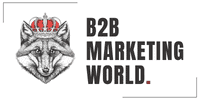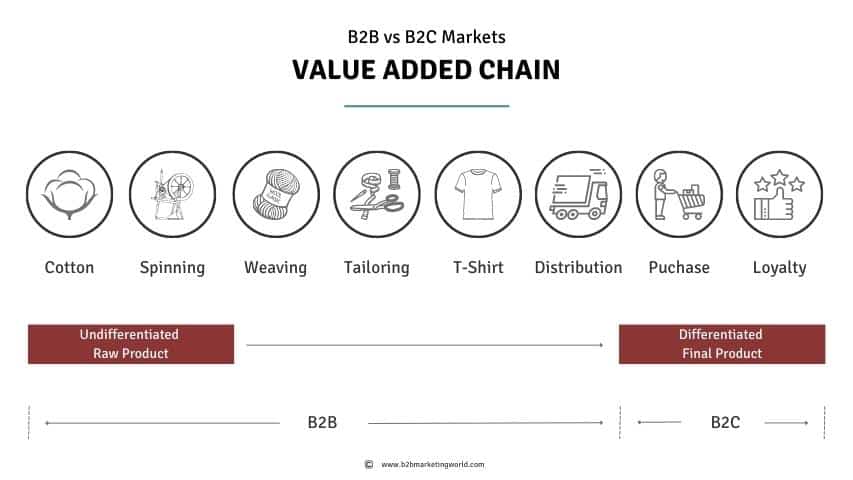Marketing for High-Tech Companies is boring? Wrong! It is an essential part of your company’s success.
It is not just about having the best product. It is about effectively communicating your message to the right audience. B2B Marketing helps you to achieve this.
This article will explore challenges like complex products and the long sales cycle. Further, we outline strategies to overcome the challenge of limited resources and tackle barriers in global markets.
Let’s go.
What is B2B Marketing for Technology Companies
Understand How Business Marketing Can Help You
Chapter Overview
B2B Marketing is essential for any technology company to realize growth strategy. In a competitive technology market, B2B marketing can help companies to:
- Reach new customers,
- Build relationships with existing customers
- Increase their business success.
But what exactly is B2B marketing, and why is it so crucial for tech companies?
What is B2B Marketing?
B2B Marketing focuses on promoting products or services to other businesses rather than directly to consumers (B2C). This marketing approach is often more complex and strategic than B2C marketing. It requires a deep understanding of the customer’s needs and the technology landscape.
The below image outlines the difference between B2B and B2C markets along the Value Added Chain.
B2B Market vs. B2C Market along the Value Added Chain © B2B Marketing World
How does B2B Marketing Help to Increase Business Success?
B2B marketing helps increase your technology company’s business success and create more effective marketing strategies that resonate with its target audience. Researching and understanding different market segments’ specific needs is the base. Additionally, build interactive, technical product demonstrations by leveraging the latest technology. Examples are virtual and augmented reality. This helps you stand out from the competition and showcase complex technical details. Finally, build your brand reputation through thought leadership and reputation management. The aim is to establish your company as an expert and build customer trust.
Why do Technology Companies Need Marketing?
Marketing is a critical business task for technology companies. Probably even more than it is for B2C companies. Marketing aims to reach new customers, establish a strong brand reputation, and stand out.
Through Marketing, you can educate your target audience and show them how you can solve their problems.
Challenges of B2B Marketing for Technology Companies
The 5 Biggest Challenges for B2B Companies
Chapter Overview
B2B marketing for high-tech companies is a complex and challenging task requiring unique skills and strategies. The technology industry is known for its rapid pace of innovation, fierce competition, and complex products and solutions that need a high level of technical expertise to understand and market effectively. Technology companies need to be strategic and innovative in their approach to marketing.
This chapter will dive into the specific challenges these B2B companies face.
We will explore the obstacles that must be overcome to succeed in the high-tech B2B market. Further, we also help overcome these challenges and achieve success in the B2B tech market.
Learn the tips, tricks, and strategies to make your B2B tech company stand out, including:
Complex Products and Solutions
High-tech products and solutions are complex. This is a significant marketing challenge for B2B companies. These products often need high technical expertise to understand their benefits. For example, marketing a software application to a company requires a deep understanding of the software’s features as well as the specific needs of the target market.
Marketing complex products and solutions requires a different approach than traditional B2B marketing. Instead of focusing on the product itself, marketing efforts should focus on the problem the product solves. As well as the value it brings to the customer. This job requires a deep understanding of the target market and consumer pain points. And the ability to communicate that value clearly and compellingly.
A team with technical expertise helps to define marketing messages and explain the product to potential customers. This may include hiring marketers with a specific technology or industry background. Training and education for all marketing employees are essential.
One strategy that can market complex portfolios is creating educational content. This content type helps educate potential customers on the product and its value while positioning the company as an expert. The aim of this strategy is know-how leadership. This approach is also called thought leadership. We will get to this later.
In summary, B2B marketing for technology companies requires a deep understanding of the product and its value. Further, you need knowledge about the target market and the ability to communicate key product features. Companies can use this aspect for marketing their complex products and solutions.
Long Sales Cycles
B2B sales cycles tend to be longer than B2C, making it difficult for companies to generate consistent leads and revenue. This is because B2B sales often involve many decision-makers and long-term contracts.
The longer sales cycle can make it difficult to accurately predict revenue and plan for future growth. Instead of focusing on closing a sale fast, B2B marketers must build relationships and trust. This is more important than closing a deal quickly. It also requires a different approach to lead generation and nurturing.
A focus of B2B marketers is on lead nurturing strategies. Content for lead nurturing may include creating educational content, for example, blog posts, e-books, and webinars. The aim is to educate potential customers on the product and its value. An extra advantage is to create trust. Other strategies are attending networking events and industry conferences to build relationships and generate leads.
Another strategy for technology companies that can be effective in managing the long sales cycle is lead scoring. Lead scoring assigns a numerical value to leads based on their likelihood of becoming customers. B2B marketers can focus their efforts on the most promising prospects by identifying the leads most likely to convert.
By implementing these strategies, companies can increase the chances of turning leads into customers and generating consistent revenue over time. Plus, your B2B technology marketing actions are measurable – a significant advantage for ROI discussions.
High Competition
Many B2B technology industries have intense competition. This can make it difficult for companies to stand out in the market, attract new customers, and generate leads and revenue.
It would be best if you thus differentiated yourself from your competitors. This can be done by highlighting products’ unique features and benefits and emphasizing the company’s expertise in the industry. Companies should also focus on building a solid reputation. This includes clear brand messaging, a robust digital presence, and engaging with customers through social media.
Another marketing strategy for standing out in a competitive market is to focus on a niche within the industry. High-tech products and solutions are often sold to specific niche markets. Companies can gain a competitive edge by identifying and targeting these niche markets. These niches are typically international or global. Hence, technology companies have high export ratios.
Another approach to gaining a competitive edge is to leverage technology and data to optimize marketing campaigns. For example, using data analytics to identify the target audience, their needs, and their pain points can help to tailor the message. This increases the effectiveness of marketing campaigns. Automation tools streamline marketing processes and allow companies to be more efficient.
Finally, companies can differentiate themselves by offering exceptional customer service and support. Create a loyal customer base and establish a strong reputation in the market by providing a high level of service and support.
By implementing these strategies, companies can gain a competitive edge and increase their chances of success in a competitive high-tech industry.
Limited Resources of Small and Medium-Sized B2B Tech Companies
Small and medium-sized B2B companies often need more marketing resources. Limited budgets, staff, and expertise make it difficult to compete with larger companies. Fierce competition in the high-tech industry market makes this even more challenging.
To overcome this challenge, you must act strategically in your marketing efforts. One option is to identify and target niche markets with less competition. Niches marketing has, if done right, a higher likelihood of success. It can also involve focusing on inbound marketing strategies. A cost-effective way to generate leads and build relationships with potential customers.
Another marketing strategy is to leverage partnerships and collaborations. B2B technology companies can partner with other companies to expand their communication impact. Choose a partner with complementary solutions and products.
Small B2B companies can also leverage technology to streamline processes. This saves time and resources. Marketing automation tools automate repetitive tasks and allow you to focus on more important work.
Cultural and Language Barriers of Global B2B Technology Companies
Navigating cultural and language barriers can be a significant challenge. Even more so if B2B companies target a global market. Different cultures have different values, norms, and communication styles. This makes it difficult for companies to market their products the same way as in their home market. Also, language barriers hinder companies from communicating effectively with potential customers in different countries.
A big challenge is the risk of intercultural misunderstanding. It happens when companies fail to fully understand their target market’s cultural norms and values. For example, a company may use humor in its marketing materials that customers in another culture do not understand or appreciate. Companies then struggle to ensure consistency and effective communication.
To overcome the challenges of cultural barriers, B2B companies need to be mindful of cultural differences. Knowledge about local culture allows for tailoring their marketing efforts. Use market research to understand the cultural norms and values of the target market. Based on this, adapt your marketing materials to be culturally appropriate.
Another strategy you can use is installing a global team of marketers. Each core target market needs its marketer. Hire diverse marketers from different countries and cultures and train them on your corporate marketing approach. This will ensure understanding and working effectively with customers in different cultures.
Chapter Summary
In summary, the challenges of B2B marketing for technology companies can be significant and diverse.
It is a challenge to understand and effectively market complex products and solutions. They often require high technical expertise. B2B sales cycles tend to be longer than in B2C, making generating consistent leads and revenue difficult.
Another challenge is the high competition in the high-tech industry. Companies are challenged to stand out in the market. Small and medium-sized B2B companies often have limited marketing resources and need help to compete with larger companies.
Finally, B2B companies operating on a global market may need help understanding different cultures and languages. This makes it harder to market products effectively. Intercultural misunderstanding can lead to lasting brand damage. An international team of marketers helps to overcome these challenges. Researching the target market gives you the necessary insights to realize global B2B tech marketing.
B2B Marketing Strategies for Technology Companies
6 Strategies to Adress your Challenges
Chapter Overview
In this chapter, we’ll explore several strategies specific to B2B marketing. The focus remains on the high-tech industry. We’ll dive into the power of inbound marketing, the effectiveness of account-based marketing, and the opportunities available when targeting a global niche market. Additionally, I show you the importance of brand marketing. And finally, how virtual and augmented reality can enhance your B2B tech marketing efforts.
Moreover, we’ll explore the importance of identifying target market segments. Thought leadership is a great way to establish a company as an industry expert.
Let’s get started on exploring these strategies in detail. Learn how they can help your technology company achieve marketing success.
These 6 strategies are essential to stand out in a crowded marketplace:
Identifying Target Market Segments
The first step of market segmentation is to understand your customers’ specific needs and pain points. Then break it down into different market segments. This approach creates more effective marketing strategies. They resonate with the target audience.
One way to identify target market segments is through market research. This can include surveys, interviews, and focus groups with current and potential customers. Market research can either be primary (doing it yourself) or secondary (e.g., buying research and interpreting them yourself). Market research provides valuable insights into market segments’ demographics, behaviors, and pain points.
Another approach is to analyze data from existing customers. The aim is to gain insights into which segments are most valuable and what messaging resonates. Look at customer lifetime value, purchase history, and engagement with marketing campaigns. For example, you may find a specific product popular among a particular age group or geographic region.
The final step is to create specific content for each market segment. This can include tailored messaging, targeted content, and customized product offerings.
Identifying target market segments is crucial in achieving B2B marketing success. Yet, the rule is “customize where necessary, standardize where possible.” Meaning, do not hyper-segment your market. It will be hard to provide specific content for many segments.
Thought Leadership
Branding and thought leadership are closely related concepts. Both are essential for B2B marketing success in high-tech industries.
A strong brand helps to differentiate from competitors and builds trust with potential customers. Branding establishes credibility in the market.
This is essential for B2B companies, even more so for B2B services and long-term projects. Often, the competence of a company is shown during the project. The other company needs to trust before buying. B2B markets need to target this key milestone of the buying process.
One effective strategy for achieving both goals is creating content demonstrating expertise and thought leadership. Educational content is the prime strategy to accomplish this goal.
Educational content can be blog posts, whitepapers, e-books, case studies, and similar deep-dive content. It is content that provides insights and solutions to your prospect’s specific pain points.
In addition to content marketing, there are other ways to establish thought leadership.
For example, by participating in industry events and speaking at conferences. This allows networking with other industry leaders. You can showcase your company’s expertise to a broader audience.
Therefore, Thought Leadership is an excellent way for high-tech B2B companies to become the industry leader.
Yet, building a solid brand and establishing thought leadership takes time and consistent effort. It’s not a one-time task. It is an ongoing process requiring continuous content creation and brand management investment.
Trust me; it is worth the effort.
Brand Marketing for B2B Technology Companies
Branding and reputation management is crucial for B2B companies in the high-tech industry. It allows you to differentiate from competitors and build trust with customers. A strong brand is a powerful asset, influencing customer perceptions and purchasing decisions.
One key element of branding is developing a clear and consistent message. This means identifying what sets your company apart. This then needs constant communication through your marketing efforts. Communicating your unique value proposition will attract the right customers and build trust.
Trust is the second significant opportunity for B2B tech companies. It is essential in buying, as industrial goods are often high-priced and includes a long collaboration with your customers.
Another aspect of branding is reputation management. This consists of identifying and addressing negative feedback and amplifying positive feedback. By managing their reputation, companies can reduce potential damage to their brand. The aim is to maintain a positive image in the eyes of your customers. As errors happen and problems are a part of business life, you must actively manage your reputation.
Further branding and reputation management must be transparent and authentic. Customers today expect companies to be open and honest in their communication. You can earn their trust and create a strong brand by being transparent and authentic.
Building a solid brand and managing your reputation takes time and effort. Yet, the described long-term benefits make it a worthwhile investment.
Inbound Marketing
Inbound marketing is one of the key opportunities ofB2B marketing in the high-tech industry. This approach focuses on creating valuable educational content. It helps to position a company as a thought leader. B2B companies can attract their target audience by providing deep-dive knowledge and insights. Leads and revenue increases are the results.
Content marketing is a core component of inbound marketing. It creates and distributes relevant and valuable content to a specific target audience. This can include blog posts, e-books, whitepapers, webinars, and more. The key is to provide truly valuable content for your target audience rather than simply promoting your products or services. This is content that increases knowledge and educates.
One key aspect of inbound marketing is building trust with customers. By providing valuable content, B2B companies can establish trust and credibility. The focus is on customer needs and challenges and how to solve them. This will lead to increased customer loyalty and ultimately results in more sales.
But, inbound marketing can be time-consuming and require a significant investment in content creation. B2B content marketers must understand their target audience to create content that resonates with them. This requires a deep understanding of customer problems and solutions to them.
Account-Based Marketing (ABM)
Do you constantly look for ways to stand out in your competitive B2B market? Account-based marketing (ABM) is a targeted, strategic approach focusing on high-value accounts. This approach allows B2B companies to tailor their marketing strategies to meet their most valuable customers’ unique needs. This is an excellent way to differentiate yourself.
A benefit of ABM is that it allows companies to build deeper, more meaningful customer relationships. You can create customized marketing campaigns by focusing on high-value accounts. These campaigns are tailored to those accounts’ specific needs and pain points. This increases customer loyalty and retention and drives more revenue for the company.
Yet, implementing an ABM strategy can take time and effort. This is especially true for small and medium-sized companies with limited resources. You need significant data analysis and research investment to develop targeted marketing campaigns. Success comes from a clear understanding of your target accounts and the specific needs of those customers. Additionally, it would be best if you had the tools to track and measure the success of your ABM campaigns.
ABM is a powerful approach for B2B companies in the high-tech industry. It allows you to tailor all marketing efforts. And to meet your most valuable customers’ unique needs.
Global Niche Marketing
Many B2B Companies are so-called Hidden Champions. Hidden Champions are world market leaders in specific niche markets but are unknown to the public. They are typically “born global” with high export ratios to serve global market demand.
The opportunity of global markets is to drive growth by expanding into new markets. Additionally, targeting global niches allows companies to focus on a specific portfolio. There is no need to diversify the portfolio, which reduces risk. This can benefit small and medium-sized companies, which may be more vulnerable to market fluctuations.
Another chance of global niches is to build a competitive advantage through a deep understanding of specific customer needs. Companies can focus on a particular niche and become experts in their field. This can help you to stand out in a crowded market and attract high-value customers globally. Furthermore, it allows B2B companies to position themselves as thought leaders. Thought leaders are considered experts in their industry. This helps you to build customer trust and credibility.
Besides, global niches can open the door to strategic partnerships. Ideal partners are other companies with complementary products. For example, if you are an expert in high-end swimming pools, look for a partner who produces the best-in-class water filer systems. Such partnerships help you to share resources, knowledge, and expertise. It also allows cross- and up-selling and gives your company access to new markets and customers. As a result, your B2B companies can leverage these collaborations to build a stronger and more competitive global presence.
Virtual and Augmented Reality
Virtual and augmented reality (VR and AR) technologies are perfect for marketing complex B2B products. These technologies offer many benefits. Especially for B2B companies looking to explain complex and knowledge-intensive products.
One of the key advantages is that it allows more interactive product demonstrations. Instead of simply showing customers a product or a design, you can use VR and AR to give them a more hands-on experience. This can be especially useful for complex or high-value products. Customers see precisely how the product will work and how it can benefit them. Your customers understand the solution more likely. This is a massive advantage in the sales process.
For example, an industrial machinery manufacturer can use VR to give potential customers a virtual factory tour. The prospect sees how the machinery works in a real-world setting. Similarly, an architectural firm can use AR to overlay virtual designs onto a real-world building site. This gives the clients a better understanding of how the final project will look.
Another advantage of VR and AR is creating a more memorable experience. With the help of this technology, you can establish an emotional connection with your customers. This can lead to increased customer engagement, leading to more sales.
Additionally, VR and AR can help with practical training and educational materials. Valid for both customers and employees.
This approach has many advantages, but creating VR and AR content can be challenging. You need the necessary hardware and software infrastructure to support it. And most important, marketers or agencies that create the content.
Therefore, consider whether VR and AR are the right choices for your company. Make sure to weigh the potential benefits against the costs.
Chapter Summary
This chapter has explored the various marketing strategies available to B2B high-tech companies. B2B technology marketing offers a valuable opportunity with inbound marketing.
Inbound marketing is a key opportunity for B2B marketing by creating valuable educational content that increases knowledge and education. Account-based Marketing (ABM) is a targeted, strategic approach that allows B2B companies to build deeper customer relationships and increase customer loyalty and retention.
Global niche marketing can help B2B companies drive growth, create a competitive advantage, and position themselves as thought leaders. Branding and reputation management is essential for B2B companies in the high-tech industry to differentiate from competitors and build customer trust.
VR and AR are ideal for marketing complex B2B products, allowing for more interactive demonstrations and a more memorable experience.
Summary [TL;DR]
B2B Marketing for Technology Companies in a Nutshell
High-Tech companies in a B2B market have a couple of challenges. This includes internal aspects such as complex products and solutions or limited resources of small and medium-sized companies. As well as environmental things like long sales cycles, high competition, and the challenge of navigating cultural barriers in a global market.
These challenges, however, also create opportunities for B2B marketers. There are some proven marketing strategies for tech companies to overcome these threads.
Strong branding with a focus on though-leadership establishes trust. Position your company as the expert source for all problems of a market segment. This approach requires valuable content and is a long-term game. This strategy can be efficiently combined with inbound marketing. Instead of reaching out via cold calls, your marketing effort focuses on being a relevant resource for all customer questions.
Segmentation and the focus on global niches give many “born global” technology companies the possibility of global marketing. Once cultural barriers are overcome, a global acting B2B company can target a vast market potential.
Further, modern technology like augmented and virtual reality help to showcase complex products understandably.
Combining all these strategies creates a solid multichannel marketing mix built on a strong strategic base.
Stephan Wenger
B2B Marketing Expert, Editor and Marketing Management Consultant
Stephan Wenger is a seasoned B2B Marketing Expert with more than 10 years of experience in leading global companies. His extensive expertise lies in the realms of B2B online marketing, content marketing, strategic marketing, and driving synergy between sales and marketing, including effective lead management.
You May Like the Following Articles
B2B Marketing Strategy
Marketing Strategy. Marketing Plan. Marketing Tactic. There are different terms to describe the purpose of your B2B marketing efforts. This article not only defines these phrases but also outlines the correlation between the company vision and aims. Reading this article, you can develop a proper marketing strategy.
What is a B2B Marketing Plan?
When running a business, you most likely thought about marketing. And about how marketing can help you to win customers. A marketing strategy and marketing tactics are also necessary for B2B companies. This article will show the fastest way to fail and how to craft a basic B2B marketing plan.





